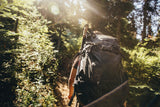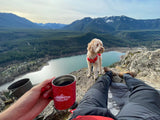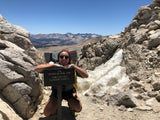The History of Snowshoeing: A Trek Through Time

For those curious, it turns out the history of snowshoeing is somewhat mysterious. The archeological record is slim when it comes to the origin of snowshoes, and recent developments in the understanding of how humans came to the Americas have put something of a wrench in the gears of the generally accepted theory.
The theory which currently exists in snowshoeing circles is around 4,000 BCE, the practice of wearing a shoe to disperse the force of your foot hitting the snow and keep you from sinking with every step began in Central Asia. As these humans dispersed around the globe, these “shoes” evolved to take on different forms and purposes. The groups that travelled westward from Central Asia and eventually landed in modern Europe tweaked and fiddled until they came up with what we now refer to as the Nordic Ski.
The groups that traveled east crossed the Bering Strait and eventually made it to the Americas, gradually dispersing downward. As tribes formed and spread out across North America, each modified the snowshoe to fit the needs of their environment. The Cree created the longest snowshoe, at around 6 feet long with a turned-up toe, for hunting across large plains. On the other hand, the Iroquois created, narrower, shorter shoes to achieve more maneuverability in densely forested areas.

One interesting tidbit is that it is a common misconception that Inuit were the biggest users of the snowshoe in North America. In fact, they did not use snowshoes all that much due to the fact they did most of their winter foot travel over sea ice. The problem with this theory is twofold. First, it is theorized that the Bering Strait was crossed multiple times from between 30,000 years ago to 16,000 years ago, when the last ice age ended and the Bering Strait flooded, becoming impassable by foot. This is earlier than the 6,000 years ago that snowshoes were supposedly developed in Central Asia. The second issue is that recent evidence has been gathered to suggest that humans arrived in North America in ways other than the Bering Strait.
Is it possible that snowshoes were brought to the Americas by boat instead of by foot? It is possible, but, as mentioned previously, the archeological record is slim, and we do not have enough evidence and information yet to fully understand the origins of snowshoes.
Despite having limited insight into the origins of snowshoes, we do know plenty about their more recent history. Across North America, snowshoes were one of the cultural elements common to all tribes that lived where snowy winter conditions were common. In today’s geography, the tribes that lived in Canada and the Northern United States even stretched to some more southern areas. We also know that snowshoes made it to Europe in the late 1600s due to the colonial presence in North America. This began with the French relationship with the Cree, Heuron, and Algonquin. The French learned from these native groups in order to hunt, trap, and trade.

The French use of snowshoes grew in popularity even more during the French-Indian Wars. This most famously happened in the Battle on Snowshoes in 1758 when the British fought the French and their Native American allies in what is now upstate New York, near Lake George. The battle was apparently fought on top of four feet of snow. Prior to this, around the year 1690, the French-Native American alliance attacked a British settlement. The British colonials managed to capture snowshoes and pursued their attackers for nearly 50 miles to recover the people and goods taken by the French and Native Americans.
The use of snowshoes outside of the strictly practical has likely been around as long as snowshoes have. Many Native American tribes, including the Ojibwa, used the shoes in dances and likely for sport as well. This tradition was picked up by European-Canadians and started to spread and become a popular sport for many by the 1840s, which is when the first snowshoe club was founded. The Montreal Snow Shoe Club was founded in 1843 and was the first of many snowshoeing clubs, especially in Canada where there are many snowshoe clubs today. It was at these club meetings that races were held.

The two main types were dashes and hurdles. Dashes were typically around two miles in distance and hurdlers leaped over four-foot-high barriers. There is reasonable evidence that the snowshoeing hurdle race began around a decade before the summer version of the race. And this is not the only impact snowshoeing has created in the running world. The term “jogged” was first used to describe the slow, steady pace of snowshoers during the early 1870s. On top of this, until 1945, track athletes would use snowshoes to train during winter if they didn’t have access to quality indoor training venues. By 1870, snowshoeing clubs had spread to Ottawa, Toronto, and Quebec City, in addition to becoming much more competitive.
This prompted the introduction of the Tecumseh Cup, a snowshoe racing trophy, and the reduction of weight of snowshoes from four pounds to one and a half pounds. By the early 1880s, skating rinks’ biggest events were annual snowshoe races, and snowshoeing, in general, was the most popular winter pastime for European-Canadians. The advent of ice hockey in the 1890s took the wind out of the snowshoeing’s sails in Canada, but further developments in snowshoes were not far off.

In the 1950s, Tubbs, a Vermont based company, created the “Green Mountain Bearpaw,” which combined the short style of the typical Bearpaw snowshoe with a very narrow width. This happened at the beginning of a boom in recreational use of snowshoeing and was the most popular type of snowshoe for about 20 years, until 1972. In 1972, the variety of snowshoe you are most likely to see today was invented by Gene and Bill Prater in the Cascade Mountains in Washington State.
They replaced the wood frame of snowshoes with aluminum, the leather and lace binding with a neoprene and nylon decking, and added cleats to the bottom of the shoe (this was to give the shoes more bite and traction for mountaineering). This shoe was lighter and more durable. In addition, whereas with a wooden shoe, a great deal of maintenance was required, including treatment with spar varnish and replacing rawhide lacing, aluminum or stainless steel, and nylon and neoprene shoes required very little maintenance. The introduction of crampons also made snowshoes more appealing to mountaineers. Now, snowshoes are made with an even lighter plastic, polypropylene, and there are even inflatable snowshoes made of fabrics like Cordura and thermoplastic polyurethane.

Today, snowshoeing has become a very popular form of winter recreation. In the 1990s, snowshoe usage tripled in the United States of America and continues on a distinct rise in popularity to this day. Snowshoes allow their user to trek across snowy terrain without being bogged down by sinking through inches or feet of snow with every step. They also allow access to a unique view of any hiker’s favorite trails. A hike down a snow-covered trail can be a breathtaking, new experience even if you have been down that same trail a hundred times before.
-
Shop the gear in this post:






